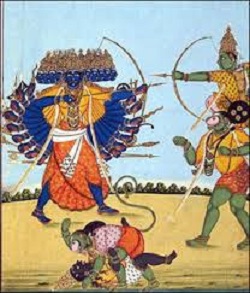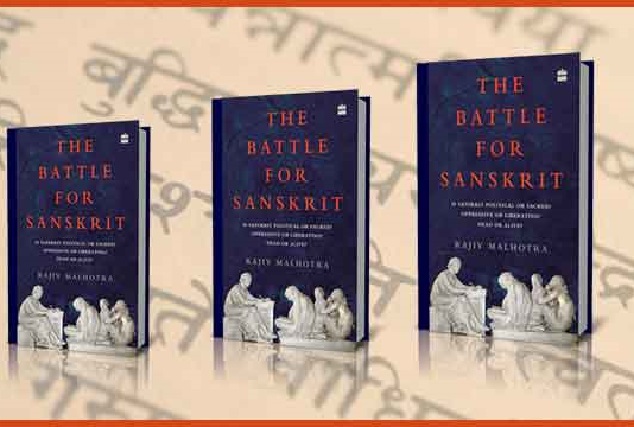Rajiv Malhotra’s new book, “The Battle for Sanskrit” (www.thebattleforsanskrit.com), is a must-read book that exposes efforts underway by Sheldon Pollock and other Indologists to essentially de-sanctify Sanskrit and reinterpret it through a Marxist lens.
In this book, Malhotra explains clearly and simply the key ideas in this body of scholarship and what is at stake for Hindus and India as these ideas are being carefully fed into the mainstream culture and media. Malhotra has distilled the arcane complexities of enormous tracts of Sanskrit scholarship into a clear narrative, has explained the stakes of the debate between these scholars and a traditional view of Hinduism and has offered a compelling rebuttal to their main arguments.
The Importance of Samskriti
This is a battle not just over the language of Sanskrit but the very samskriti that constitutes Indic civilization. Samskriti is one of a set of three related words: prakriti (basic matter or condition), samskriti (refined matter or condition) and vikrti (modified or decayed matter or condition). Samskriti is what makes the block of stone of prakriti into a beautiful sculpture, or a piece of jewelry out of the prakriti of a lump of gold, as beautifully explained by Swami Harshananda. In terms of civilization, samskriti is what makes a society a nation and a nation a civilization, what binds together a people and gives them an identity, a common purpose and set of values by which to live.
Our samskriti consists of the epic histories recording the deeds of our forefathers as told to us through the Ramayana and the Mahabharata, the metaphysical and philosophical frameworks underpinning the Vedas and the Vedangas that are encapsulated in our classical arts, our sacred texts and the language of Sanskrit—which is the language of our devas, the language of our rites of worship and the mother language of the vernaculars that we speak today.
Making the Spiritual Political — Reinterpreting Hinduism through a Marxist Lens
According to Pollock and this school of Indologists, Hindu sacred traditions and texts should be stripped of their spiritual elements and reinterpreted through a purely political perspective. In their view, Sanskrit’s main purpose is not as a medium for expressing the religious, aesthetic and artistic ideals of the Indic people, but rather is a political tool of oppression by the elites against shudras, non-Aryans and women in particular.
Co-Opting Traditional Hindu Voices to Support a Marxist Agenda
What makes this school of Indologists especially dangerous is that their scholarship is not limited to arcane textbooks or the halls of the Ivory Tower. Their distortions of the Sanskrit tradition are going mainstream.
 Pollock himself has gone mainstream. His work has filtered through into mainstream media explanations of Indian politics and popular cultural depictions of the Ramayana. For example, the politicization of the Ramayana and the casteist interpretation of it as pioneered by Pollock has been echoed by Devdutt Patnaik and others, as seen for example in the popular new Star Plus TV serial, Siya ke Rama. Pollock is the driving force behind the Murty Classical library, a huge project to translate into English the classical literature of Indian civilization. He is in effect defining what should be deemed to be our classical texts and how they should be interpreted.
Pollock himself has gone mainstream. His work has filtered through into mainstream media explanations of Indian politics and popular cultural depictions of the Ramayana. For example, the politicization of the Ramayana and the casteist interpretation of it as pioneered by Pollock has been echoed by Devdutt Patnaik and others, as seen for example in the popular new Star Plus TV serial, Siya ke Rama. Pollock is the driving force behind the Murty Classical library, a huge project to translate into English the classical literature of Indian civilization. He is in effect defining what should be deemed to be our classical texts and how they should be interpreted.
Pollock is also attempting to co-opt the most powerful traditional Hindu religious institutions into his avowedly anti-Hindu mission. For example, he has targeted Sringeri, the very first matha founded by Adi Shankaracharya, to sponsor named university chairs that would carry on this kind of scholarship in the name of Sringeri without giving Sringeri any control over the scholars selected or the scholarship pursued. Were such a plan to succeed, it would be tantamount to the Vatican authorizing an atheist to represent its interests and speak on its behalf and in its name.
We are losing control over our own Samskriti
Imagine the ironies of this situation. If we care about Indic civilization, the most ancient surviving religious tradition in the world, if we care about the preservation of the legacy of our ancestors, of retaining the integrity of that culture and religion which has been so carefully transmitted to us from generation to generation over so many thousands of years, then how can we so carelessly give away custodianship of that samskriti to those who do not have the loyalty to our tradition or a vested interest in its preservation?
That which is most precious to us should also be the most carefully protected and safeguarded. When it comes to financial wealth, we entrust it only to those who are properly credentialed and who owe us a fiduciary duty to safeguard and protect our assets. How bitterly ironic that we are willing to squander away the wealth of our civilization into the hands of those who do not even respect the sanctity of our traditions, who do not believe in our Dharma, whose views and interpretations of our traditions are completely at odds with the teachings of our acharyas and rishis.
Malhotra’s Call to Action – A Call We Must Heed
In many ways, this is Malhotra’s most challenging book yet. The subject matter is tough and vast in scope. It requires deep study. Pollock is not obnoxious in his writings or overtly anti-Hindu the way Doniger and her ‘children’ have been. To engage him meaningfully requires deep research and careful study.
 Much is at stake. Mere armchair activism will not suffice. We have to assert ownership over our own traditions. We have to study our traditions and define them for ourselves. For, the core problem is not what Pollock and others are doing. The core problem is what we ourselves have not done. We have abdicated our responsibilities towards Dharma. We have not preserved our Sanskrit manuscripts; we have not created classics libraries of our own; we have not written proper English translations of our shastras.
Much is at stake. Mere armchair activism will not suffice. We have to assert ownership over our own traditions. We have to study our traditions and define them for ourselves. For, the core problem is not what Pollock and others are doing. The core problem is what we ourselves have not done. We have abdicated our responsibilities towards Dharma. We have not preserved our Sanskrit manuscripts; we have not created classics libraries of our own; we have not written proper English translations of our shastras.
It is a very sorry state of affairs indeed. Our traditional institutions of religious learning were destroyed by the British and have yet to be rebuilt. Sanskrit is studied more seriously outside of India than within India. There are no proper Hinduism studies or Indology programs in India, none that would rival the clout of Harvard or the University of Chicago. The study of Indic civilization, the history of our people and our lands, the substance of our religious traditions, are being researched and written about not by us but by those who are studying us from the outside.
In this vacuum, in this complete absence of a Hindu ‘home team’ of scholars, it is inevitable that others would step in and take up the mantle we have discarded. If we do not take up ownership of our own traditions, if we do not invest the resources to study and practice and preserve them, it is inevitable that others will rewrite our history and samskriti for us. And in the process we will have lost that which is the most valuable to us, that which defines us and binds us together.
And this is the central challenge and plea embedded in Malhotra’s book, that we must realize before it is too late the game that is being played by the other side, what is at stake in this battle, how is it to be fought, and then we must act. We have to rebuild our traditional institutions of learning. We have to develop a generation of Hindu scholars immersed in the tradition and yet also conversant in Western philosophy and lingo and savvy enough to debate and debunk it. We have to stop outsourcing the work of studying and teaching our samskriti. Hindus can no longer afford to be content with taking shortcuts to learn about Hinduism from TV serials or Facebook posts or articles in the mainstream media. We must delve deep into our tradition, into the primary sources, into the wonders of Sanskrit. We must learn and experience for ourselves the great treasures of spirituality, philosophy, ethics and literary masterpieces bestowed upon us by our ancestors. The battle for Sanskrit is on, and it is a battle we cannot afford to lose.

